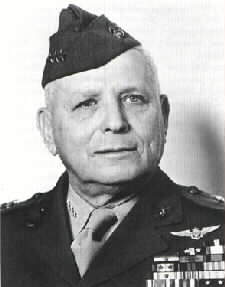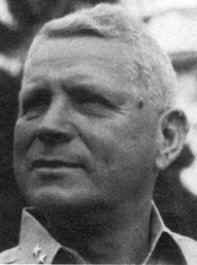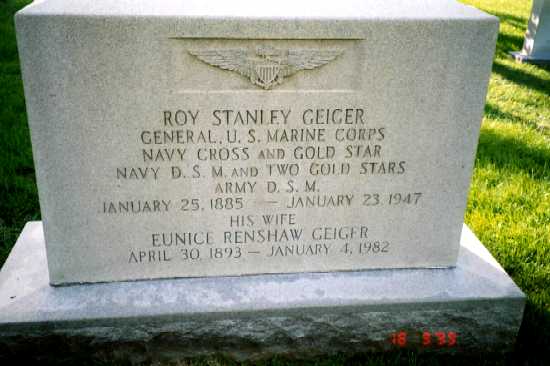
General Geiger entered flight training at Pensacola, Florida in March 1916 and became the Marine Corps' fifth aviator in June 1917. In France during World War I, he commanded Squadron “A” of the First Marine Avaition Force. After the war, his duties were divided between aviation commands, attendance at Staff Colleges, Director of Aviation at Headquarters Marine Corps and Naval Attache', London, England. At the outbreak of World War II, General Geiger was in command of the First Marine Aircraft Wing, Fleet Marine Force. He led the 1st Marine Air Wing at Guadalcanal from 3 September to 4 November 1942. In 1943 he returned to Headquarters Marine Corps as the Director of Aviation. He returned to the field in November 1943 as the Commanding General of the First Marine Amphibious Corps, (later designated Third Amphibious Corps) which he led at Bougainville, Guam, Peleliu and Okinawa. It was at Okinawa that General Geiger's command was part of the 10th Army of General Simon Bolivar Buckner, U.S. Army. When General Buckner was killed, General Geiger assumed command of the 10th Army until the successful conclusion of the campaign.
General Geiger commanded the Fleet Marine Force, Pacific from July 1945 until he was called back to Headquarters Marine Corps in November 1946. Three months later, on 23 January 1947, General Geiger died at the National Naval Medical Center, Bethesda, Maryland.
Courtesy of the United States Marine Corps:
GENERAL ROY STANLEY GEIGER, USMC (DECEASED)
General Roy Stanley Geiger, who commanded both air and ground units during World War II, and was the first Marine to lead an Army, died 23 January 1947 at the National Naval Medical Center, Bethesda, Maryland, and was buried in Arlington Cemetery.
General Geiger commanded the III Amphibious Corps in the battle for Okinawa where upon the death in action of Lieutenant General Simon Bolivar Buckner, Commanding General of the Tenth Army, General Geiger assumed command and led the Tenth Army to the successful conclusion of World War II's final campaign.
For his part in this action he was awarded the Distinguished Service Medal (Army). His citation reads in part, “Going ashore with the early landing elements on 1 April 1945, he began a bitter three-month campaign…with outstanding professional skill, forceful leadership and unswerving determination, he directed his units…repeatedly disregarding personal safety to secure a first hand estimate of the battle situation and inspiring his men to heights of bravery and accomplishment.”
General Geiger was born on 25 January 1885, in Middleburg, Florida. He attended Florida State Normal and received an LLB from Stetson University, following which he enlisted in the Marine Corps on 2 November 1907. He was commissioned a Second Lieutenant on 5 February 1909.
Following attendance at the Marine Officers' School at Port Royal, South Carolina, he served as a member of the Marine Detachments aboard the USS Wisconsin and the USS Delaware. In August 1912, he went to foreign shore duty in Nicaragua and while in that country participated in the bombardment, assault and capture of Coyotepe and Barranca. Further foreign shore duty followed in the Philippines and China with the First Brigade and with the Marine Detachment, American Legation, Peking, China, from 1913 to 1916.
In March 1916, General Geiger joined the Naval Aeronautic Station at Pensacola, Florida, as a student naval aviator. He successfully completed the course and was designated a naval aviator in June 1917.
Further training followed and in July 1918, he arrived in France. He served with Group Number Five, Royal Air Forces at Dunkerque. He commanded a squadron of the First Marine Aviation Force and was attached to the Day Wing, Northern Bombing Group. He was detached to the United States in January 1919. For distinguished service in leading bombing raids against the enemy, he was awarded the Navy Cross.
From December 1919 to January 1921, he was a squadron commander with the Marine Aviation Force attached to the First Provisional Brigade in Haiti. Upon return to the United States and after duty at the Marine Flying Field, Marine Barracks, Quantico, Virginia, he attended Command and General Staff School at Fort Leavenworth, Kansas. He graduated in June 1925. Again he went to foreign shore duty, commanding Observation Squadron Two with the First Brigade in Haiti.
In August 1927, he returned to Quantico as a squadron officer and instructor at the Marine Corps Schools, and in May 1928, was assigned to duty in the Aviation Section, Division of Operations and Training, at Headquarters Marine Corps. After attending the Army War College and graduating in June 1929, he was ordered to Quantico, where he was assigned duty as Commanding Officer, Aircraft Squadrons, East Coast Expeditionary Force. He returned to Washington for duty with Aeronautics, Navy Department as Officer in Charge, Marine Corps Aviation.
In June 1935, he returned to Quantico as Commanding Officer, Aircraft One, Fleet Marine Force. From June 1939 to March 1941, he was a student at the Senior and the Advanced Courses, Naval War College, Newport, Rhode Island. This was followed with a brief tour of duty in the Office of the Naval Attache, London, England. In August 1941, he became Commanding General, 1st Marine Aircraft Wing, Fleet Marine Force, in which capacity he was found upon this country's entry into World War II.
He led the 1st Marine Aircraft Wing from 3 September to 4 November 1942, while stationed at Guadalcanal. For extraordinary heroism in this capacity as well as commander of all aircraft, he was awarded a Gold Star in lieu of a second Navy Cross. His citation reads in part, “Despite almost continuous bombardment by enemy aircraft, hostile naval gunfire and shore based artillery, the combined total of Army, Navy and Marine Corps units stationed at Guadalcanal under Major General Geiger's efficiently coordinated command succeeded in shooting down 268 Japanese planes in aerial combat and inflicting damage on a number estimated to be as great…Sank six enemy vessels, including one heavy cruiser, possibly sank three destroyers and one heavy cruiser, and damaged 18 other ships, including one heavy cruiser and five light cruisers.”
He was recalled to Headquarters Marine Corps in May 1943, to become Director of Aviation. In November 1943, he returned to the field, this time as Commanding General of the I Amphibious Corps and led the Corps from 9 November to 15 December 1943, in the Bouganville Operation, for which he was awarded the Distinguished Service Medal.
Redesignated III Amphibious Corps in April 1944, he led this organization in the invasion and subsequent recapture of Guam during July and August, 1944, and in the assault and capture of the southern Palau Islands in September and October of the same year. For those operations he was awarded two Gold Stars in lieu of a second and third Distinguished Service Medal.
General Geiger led this Corps into action for the fourth time as part of the Tenth Army in the invasion and capture of Okinawa. In July 1945, he assumed duties as Commanding General of the Fleet Marine Force, Pacific, which position he held until called back to Headquarters Marine Corps in November, 1946.
In addition to the Navy Cross with Gold Star and the Distinguished Service Medal with two Gold Stars, his decorations and medals include the Distinguished Service Medal (Army) Okinawa; Presidential Unit Citation, Guadalcanal, 1942; Nicaraguan Campaign Medal, Nicaragua, 1912; Expeditionary Medal with two Bronze Stars, icaragua 1912, China 1914, Haiti 1919 and 1929; Victory Medal with Ypres Lys Clasp, France 1918; Haitian Campaign Medal, Haiti 1919 and 1920; Second Nicaraguan Campaign Medal, Nicaragua 1931; American Defense Service Medal; Asiatic-Pacific Campaign Medal; American Campaign Medal; World War II Victory Medal; Dominican Medal of Military Merit; Nicaraguan Medal of Distinction and Diploma.
General Geiger was promoted to four-star rank posthumously by the 80th Congress to be effective from 23 January 1947.
General Geiger entered the US Marine Corps in 1907 as an enlisted man, receiving his commission in 1909. He served in both World War I and II.
His name was intimately connected in two wars with some of the most glowing chapters of Marine Corps history.
As the first Marine Corps officer with an aviation background to rise to tactical command of all USMC forces in the Pacific in World War II, he achieved a unique distinction that typified traditional leatherneck claims to versatility.
At Okinawa, after the battle death of Army Lieutenant General Simon Bolivar Buckner, Jr., he succeded to the command of the 10th United States Army, the first time that a Marine Corps officer had attained such standing.
After the war he commanded the Fleet Marine Force Pacific and was posthumously promoted to full general by the 80th Congress. (1885-1947)
Michael Robert Patterson was born in Arlington and is the son of a former officer of the US Army. So it was no wonder that sooner or later his interests drew him to American history and especially to American military history. Many of his articles can be found on renowned portals like the New York Times, Washingtonpost or Wikipedia.
Reviewed by: Michael Howard


